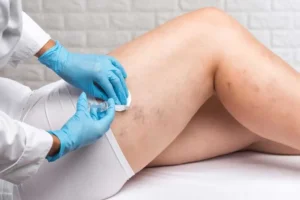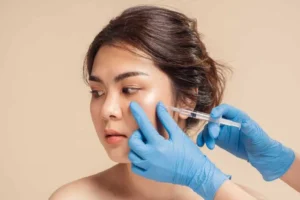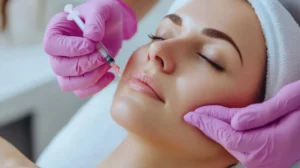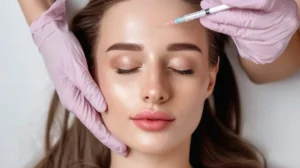Many people undergo hair loss, which can significantly negatively impact their self-esteem. Thankfully, the field of aesthetic medicine has brought forth innovative solutions, offering new hope to those facing hair thinning. Among these solutions is the groundbreaking Platelet-Rich Plasma (PRP) treatment, redefining the approach to hair rejuvenation.
What is PRP?
Platelet-Rich Plasma (PRP) is a medical treatment derived from a patient’s own blood. Platelet-rich plasma is separated from the patient’s blood using a centrifuge, and this concentrated plasma is then injected back into the patient. In addition to their function in clotting and healing, platelets also secrete proteins and growth factors that aid in tissue repair and regeneration.
PRP has a diverse range of medical applications, such as in orthopedics, wherein it’s used for treating joint and muscle injuries due to its potential to promote healing and reduce inflammation. The cosmetic industry uses PRP in “vampire facials,” believing the growth factors stimulate collagen production and enhance skin texture. Additionally, PRP has shown promise in hair restoration by potentially stimulating dormant hair follicles, and it’s used in dental medicine to foster quicker post-surgery healing.
The main benefit of PRP is that it is autologous, meaning that because it is made from the patient’s own blood, there is no chance of an allergic reaction or disease transmission. However, its efficacy is still a topic of research, and results can vary between individuals. PRP should be administered by qualified professionals, as with any medical procedure, and anyone thinking about it should consult a medical practitioner to learn about the potential advantages and disadvantages.
How Does PRP Work for Hair Restoration?
Platelet-Rich Plasma (PRP) has evolved as a promising method in hair restoration due to its potential to rejuvenate hair follicles. Here’s how it functions:
- Collection: A blood sample is initially taken from the patient, much like a routine blood draw.
- Processing: The next step involves placing this blood sample in a centrifuge, a device that spins rapidly. The centrifugation process separates the blood components, isolating the platelet-rich plasma from the rest.
- Injection: Once the PRP is separated and concentrated, it is injected into targeted scalp areas where hair loss or thinning is most prominent.
- Stimulation: The growth factors present in PRP play a vital role here. They stimulate cellular renewal, awaken dormant hair follicles, boost blood flow to the hair roots, and may even stimulate the development of new hair.
Over time and with consistent treatments, PRP aims to revitalize the scalp, boost the health of existing hair, and foster the growth of new strands. The overall goal is to achieve denser, fuller, and healthier hair.
Procedure Overview
Here’s an overview of the Platelet-Rich Plasma (PRP) procedure:
- Consultation: Prior to the surgery, patients will often meet with a qualified professional for a consultation to go over their expectations, possible outcomes, and any risks or side effects.
- Blood Collection: Similar to a standard blood test, a tiny amount of blood is collected from the patient’s arm.
- Centrifugation: A centrifuge is then used to process the blood that was collected. High-speed spinning in the centrifuge divides the blood into various layers. This allows for the isolation of the plasma portion that’s rich in platelets.
- Extraction: Once centrifugation is complete, the PRP – which is the layer containing a higher concentration of platelets than the rest of the blood – is extracted and prepared for injection.
- Application: Depending on the purpose of treatment, PRP is then either:
– Injected into the scalp for hair restoration.
– Injected into injured joints or tissues for orthopedic purposes.
– Used in tandem with microneedling for facial treatments.
– Applied to dental surgeries to promote healing.
- Post-Treatment: After the procedure, patients might experience some swelling, redness, or minor discomfort in the treated area. Depending on the exact treatment, the recovery time varies; however, for most PRP applications, a little downtime is needed.
- Follow-up: Patients usually have follow-up appointments to monitor the results of the treatment, assess the healing process, and determine if further sessions are required.
The PRP procedure may vary slightly depending on the specific medical or cosmetic application and the practices of the administering clinic or professional.
Benefits of PRP for Hair Restoration
Platelet-Rich Plasma (PRP) for hair restoration has gained traction due to its array of benefits. Here are some of the standout advantages:
- Natural Approach: PRP utilizes the patient’s blood, ensuring that the body isn’t exposed to foreign substances, thus minimizing risks of allergic reactions or adverse effects.
- Minimally Invasive: Unlike surgical procedures, PRP treatments involve simple injections, making hair restoration less invasive.
- Minimal Downtime: The procedure is relatively quick, typically lasting about an hour, and most patients can immediately return to their daily activities.
- Safety: PRP is derived from the patient’s body, reducing the chances of infections, complications, or transmissions of diseases.
- Effective Results: Many patients report a reduction in hair thinning, an increase in hair thickness, and an improvement in hair growth after undergoing PRP treatments.
- Stimulation of Dormant Follicles: PRP’s growth factors can rejuvenate inactive hair follicles, potentially leading to new hair growth.
- Enhanced Hair Health: PRP can enhance the health and texture of the hair in addition to just encouraging growth, giving it a more vivid appearance.
- Versatility: PRP can be combined with other hair restoration treatments, such as hair transplants or topical medications, to amplify results and ensure a comprehensive approach to hair restoration.
- Cost-Effective in the Long Run: Compared to lifelong treatments or other surgical alternatives, PRP can be a cost-effective solution over time.
- Quick Recovery: Post-treatment side effects, if any, are usually mild and transient, such as slight swelling or tenderness, allowing for a fast recovery period.
- As with any medical procedure, it’s critical to have an extensive consultation with a knowledgeable expert to ascertain whether PRP is the best option for your particular circumstances.
Say Goodbye to Thinning Hair
The beauty of PRP lies not just in its innovative approach but also in its ability to harness the body’s healing powers. At Torstveit Medical Aesthetics, we provide PRP (Platelet-Rich Plasma) treatments, an autologous concentration of platelets and growth factors, offering a promising solution for individuals desiring a fuller, rejuvenated head of hair. No more hiding under hats or scarves – with PRP, you can embrace a future with luscious locks, letting your hair do the talking!
Read also about : Why Should You Consider PRP Therapy?






